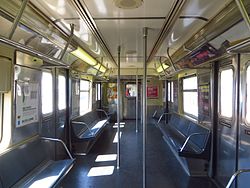R42 (New York City Subway car)
| R42 | |
|---|---|

An R42 train on the
|
|

Interior of R42 car 4573.
|
|
| In service | 1969-present |
| Manufacturer | St. Louis Car Company |
| Built at | St. Louis, Missouri, USA |
| Replaced | All remaining BMT Standards, and many R1s |
| Constructed | 1969–1970 |
| Refurbishment | 1988–1989 |
| Scrapped | 2007-2008 (NYCTA-rebuilt cars) 2009-2013 (most MK-rebuilt cars) TBD (remaining cars) |
| Number built | 400 (most retired) |
| Number in service | 50 |
| Number preserved | 5 |
| Number scrapped | 345 |
| Formation | Married Pairs |
| Fleet numbers | 4550–4949 |
| Capacity | 44 (seated) |
| Operator(s) | New York City Subway |
| Depot(s) | East New York Yard (50 cars) |
| Service(s) assigned |
|
| Specifications | |
| Car body construction | Stainless Steel with Carbon Steel chassis, roof and underbody, Fiberglass A-end bonnet and B-end top bonnet |
| Train length | 2 car train: 120.4 feet (36.7 m) 4 car train: 240.8 feet (73.4 m) 6 car train: 361.2 feet (110.1 m) 8 car train: 481.6 feet (146.8 m) 10 car train: 602 feet (183 m) |
| Car length | 60 ft (18.29 m) |
| Width | 10 ft (3,048 mm) |
| Height | 12.08 ft (3,682 mm) |
| Platform height | 3.76 ft (1.15 m) |
| Doors | 8 |
| Maximum speed | 55 mph (89 km/h) |
| Weight | 74,388.5 lb (33,742 kg) |
| Traction system | General Electric (GE) SCM propulsion system using Westinghouse 1447J motors 115 hp (85.8 kW) on all axles |
| Acceleration | 2.5 miles per hour per second (4.0 km/(h·s)) |
| Deceleration | 3.0 miles per hour per second (4.8 km/(h·s)) (Full Service) 3.2 miles per hour per second (5.1 km/(h·s)) (Emergency) |
| Electric system(s) | 600 V DC Third rail |
| Current collection method | Contact shoe |
| Braking system(s) |
CI Rebuilds: New York Air Brake SMEE/ Newtran (dynamic and friction), A.S.F. simplex unit cylinder clasp (tread) brake MK Rebuilds: WABCO "SMEE" Braking System, A.S.F. simplex unit cylinder clasp (tread) brake |
| Safety system(s) | tripcock |
| Coupling system | Westinghouse H2C |
| Headlight type | halogen light bulbs |
| Track gauge | 4 ft 8 1⁄2 in (1,435 mm) |
The R42 is a New York City Subway car model built between 1969 and 1970 by the St. Louis Car Company in St. Louis, Missouri for the (IND/BMT) B Division. It was the last 60-foot (18.29 m) B Division car built for the New York City Subway until the R143 in 2001, and the last car model class to be built in married pairs.
The R42s are numbered 4550–4949.
The R42s were the first fleet of New York City Subway cars to be fully equipped with Stone Safety 10 ton air conditioning systems/units. Such units were similarly found on the last ten R38s (4140-4149) and all R40As.
The R42s were also the first cars to use solid state converters in place of the motor-generators as standard equipment.
Although there were some slight cosmetic differences between the R42s and straight-ended R40As (such as the blind end storm doors and the side appearance of the body), the two cars were, for all practical purposes, the same car type. The straight-ended R40As and R42s often ran together, and one R42 was even mated to an R40A due to an accident on the Williamsburg Bridge on June 6, 1995.
On May 9, 1969, cars 4554-4555 entered service on the N as part of a mixed consist with straight-ended R40As. By January 5, 1970, all cars were in service.
In 1974, cars 4650-4659 and 4760-4769 were sent to Garrett AiResearch's facilities in Los Angeles, California to test out Flywheel Energy Storage System equipment. The even-numbered cars received energy conservation machinery with batteries and amber-type digital readouts indicating the amount of energy used by the equipment, while the odd-numbered cars remained untouched. These cars were later tested at the UMTA, and the USDOT Testing Facilities in Pueblo, Colorado for evaluation, and were returned to the MTA in 1976 for in-service testing on all BMT/IND Lines to check the effectiveness of the technology.
...
Wikipedia
